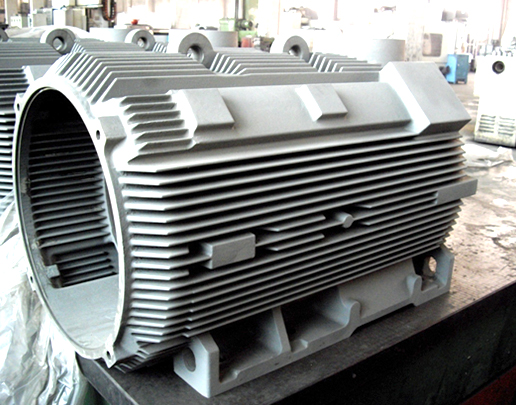As the "outer shell" of the motor, the design and manufacturing of the Dalian motor shell directly affect the performance, lifespan, and application range of the motor. With the advancement of technology and changes in market demand, motor housings will continue to develop towards lightweight, intelligent, and environmentally friendly directions, providing more reliable support for the widespread application of motors.
Die casting technology is suitable for the manufacturing of aluminum alloy motor housings, which can produce high-precision and high-strength motor housings. The mold cost of die-casting technology is relatively high, but the production efficiency is high, making it suitable for large-scale production. The injection molding process is suitable for the manufacturing of plastic motor housings, which can produce motor housings with complex shapes and smooth surfaces. The mold cost of injection molding process is relatively high, but it is suitable for large-scale production.
What are the design and structural characteristics of Dalian motor housings with different levels of protection?
The protection level of the motor casing is represented by the IP (Ingress Protection) code, with the first digit indicating the protection level against solid objects and the second digit indicating the protection level against liquids. The following are the design and structural characteristics of motor housings with different levels of protection:
IP23
Design feature: Mainly prevents objects larger than 12mm from entering, such as fingers or similar objects. The protection of liquids is to prevent vertical water droplets from entering. The motor casing usually has a simple ventilation hole design to ensure heat dissipation, but the ventilation holes are relatively large.
Structural characteristics: It generally adopts a basic shell structure, which may be welded from cast iron or steel plates. The joint of the shell, such as the connection between the end cap and the machine base, is usually sealed with ordinary gaskets or sealants to prevent small objects and vertically falling water droplets from entering.
IP44
Design feature: It can prevent objects larger than 1mm from entering, such as insects or tools. At the same time, prevent splashing water from entering and prevent splashing water from all directions from entering the interior of the motor casing. The ventilation holes of the motor housing may be designed smaller and the number may be reduced, or some protective nets may be used to block the ventilation holes to prevent small objects from entering.
Structural characteristics: In the structure of the shell, more attention will be paid to sealing. The sealing between the end cap and the machine base, junction box, and other parts will use more reliable sealing structures, such as rubber sealing rings or sealing strips. In addition, the motor shaft extension will also adopt a good sealing design, usually using oil seals or sealing rings to prevent water and dust from entering the interior of the motor from the shaft extension.
IP54
Design feature: It can prevent harmful dust accumulation and prevent splashing water from entering. The design of the motor casing will place more emphasis on dust-proof performance, and the ventilation holes may be further optimized by adopting a maze style ventilation structure or equipping with efficient dust-proof filters, which can ensure ventilation and heat dissipation while effectively preventing dust from entering.
Structural features: The overall sealing of the structure is further improved. All joint surfaces, including bolt connections, observation windows, etc., will use high-quality sealing materials and more precise processing techniques to ensure that dust and water cannot enter. Junction boxes are usually designed as sealed types with good waterproof and dustproof performance.
IP55
Design feature: On the basis of preventing dust from entering, it can prevent sprayed water from entering, and prevent large waves or water sprayed rapidly from the spray hole from entering the motor housing. The surface of the motor casing may be designed with a smooth streamlined shape to reduce the possibility of water accumulation and dust adhesion. The ventilation system will adopt more complex designs, such as adding air filtration devices, to further improve dust prevention effectiveness.
Structural features: The sealing structure is more stringent and reliable. In addition to using high-quality sealing rings and sealing strips, some key parts may adopt a double-layer sealing structure. The outlet and inlet of the motor will be equipped with specialized sealed joints to ensure that water and dust cannot enter the interior of the motor from these areas.
IP65
Design features: It has complete dust-proof ability and can prevent water from large waves from entering. It can also prevent water from large waves or rapid spray holes from entering the motor housing and causing damage. The motor casing usually adopts a design without ventilation holes to achieve complete dust prevention. If heat dissipation is required, special heat dissipation structures such as fins or ducts will be used to remove heat through external air flow.
Structural features: The overall structure adopts a fully sealed design, using welding or integrated molding processes to reduce the gaps and interfaces of the shell, and reduce the risk of water leakage and dust entering. All openings, such as inspection ports, junction boxes, etc., are equipped with high-performance sealing devices, usually made of stainless steel or corrosion-resistant materials to ensure long-term reliability in harsh environments.
IP67
Design features: On the basis of complete dust prevention, it can prevent water immersion from entering, and the motor casing can ensure that it is not damaged due to water immersion under certain pressure. The design of the motor casing needs to consider withstanding a certain amount of water pressure, so thicker materials are usually used for the casing to enhance structural strength. Some drainage or water-resistant structures, such as drainage channels or water-resistant plates, may be installed inside the motor casing to prevent damage to the motor caused by accumulated water.
Structural features: High sealing performance is required, and special sealing technologies and materials such as rubber gaskets, O-rings, etc. are used to ensure good sealing performance even in underwater environments. The cable inlet of the motor will be equipped with a special waterproof joint, which will undergo multi-layer sealing treatment to prevent water from entering the interior of the motor through the cable.
IP68
Design feature: This is the highest level of protection, requiring not only complete dust prevention, but also long-term immersion in deep water without water ingress. The motor casing is generally made of high-strength and corrosion-resistant materials, such as stainless steel or special alloy materials, to withstand higher water pressure. At the same time, special coating or surface treatment techniques will be used to improve the corrosion resistance and water pressure resistance of the motor casing.
Structural characteristics: The sealing structure has been specially designed and tested, usually using advanced technologies such as multi-stage sealing and dynamic sealing to ensure sealing performance under special conditions. All components of the motor, including bearings, windings, etc., have undergone special treatment or packaging to adapt to long-term underwater working environments. In addition, some pressure balancing devices may be equipped to balance the water pressure inside and outside the motor casing, reducing the pressure borne by the sealing components.
The motor casing needs to have sufficient strength and stiffness to withstand the mechanical stress and vibration generated during the operation of the motor. When designing, it is necessary to consider the thickness, material properties, and structural form of the shell. Heat dissipation is one of the key factors in the design of motor casings. By adding heat sinks, optimizing the layout of ventilation holes, or using materials with excellent thermal conductivity, the heat dissipation efficiency of the motor can be improved.
The motor generates a large amount of heat during operation. If it cannot dissipate heat in a timely manner, it will cause the temperature of the motor to rise, affecting its performance and lifespan. Therefore, the heat dissipation design of the motor casing is crucial. Common heat dissipation designs include: heat sinks: designing heat sinks outside the motor casing to increase the heat dissipation area and improve the heat dissipation effect. Heat sinks are usually made of aluminum alloy material, which has good thermal conductivity.






